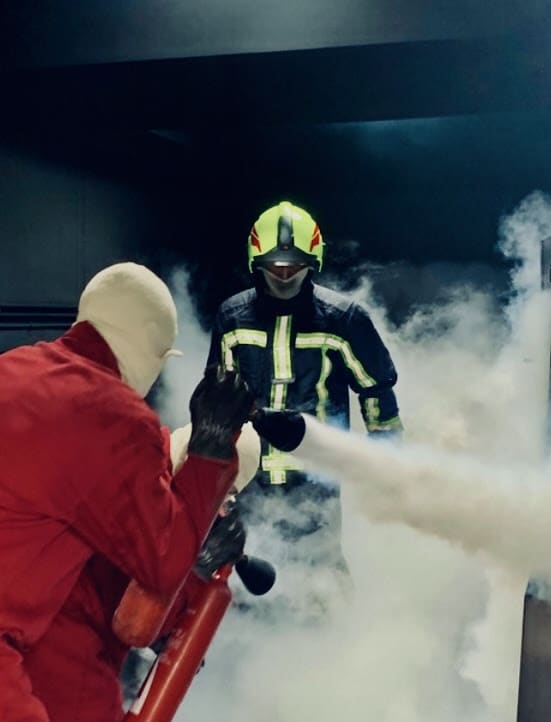PPE / ESI training: All you need to know

Find out all you need to know about PPE (First Response Crewman) and ESI (Second Response Crewman) training. From the definition to the difference between these two roles, not forgetting the legal obligations, we offer you a complete overview. Learn how to become a key player in corporate fire safety, and how to master fire-fighting techniques.
Understanding PPE and ESI
The terms EPI (Équipier de Première Intervention) and ESI (Équipier de Seconde Intervention) designate key roles in corporate fire-fighting. PPEs are the first to intervene when a fire breaks out. Their job is to use the extinguishing equipment at their disposal to bring the situation under rapid control.
On the other hand, ESIs are used to back up PPEs. Their training is more in-depth, including the use of more powerful extinguishing equipment such as fire hoses and foam generators. They ensure coordinated intervention to bring major fires under control until outside help arrives.
PPE and ESI competencies are defined in the APSAD R6 standard. These specify selection criteria, training programs and the frequency of refresher courses required to keep their skills up to date.
Definition of first response team member (FST)
A first-response team member is an employee trained to react quickly in the event of a fire. Their role is not limited to the use of extinguishing equipment such as fire extinguishers and hose reels. They must also secure the area to facilitate the intervention of outside emergency services.
IPEs have a thorough knowledge of the premises, including emergency exits and assembly points. They are also responsible for regularly checking the condition of safety equipment.
Their main missions include
- Ensuring the safety of those present
- Coordination with company fire department and external emergency services
- Evacuation of the premises according to evacuation plans
These skills enable PPE to limit the spread of fire and reduce risks to employees and property.
Definition of a second intervention team member (ESI)
Role and responsibilities of PPE
PPEs are trained to intervene rapidly in the event of fire. They must be proficient in the use of fire extinguishers and armed fire valves. Their role also includes securing the premises and evacuating personnel.
They must know how to identify sources of danger and take the necessary measures to limit risks. PPEs are also responsible for handling fire extinguishers, instruction signs and internal operation plans.
PPE's main tasks include:
- Regular checking of safety equipment
- Practical training sessions
- Coordination with emergency services
- Making colleagues aware of safety instructions
In emergency situations, they can be used to contain flames before professional help arrives. A good knowledge of the premises and emergency exits is essential for PPE.
ESI's role and responsibilities
ESIs play a crucial role in ensuring fire safety in the workplace. They are responsible for implementing advanced extinguishing systems such as fire hoses and foam generators.
Their main tasks include :
- Limit the spread of flames before help arrives
- Perform reconnaissance and rescue operations in polluted or toxic atmospheres
- Ensure the protection of people and property in collaboration with the fire department
They must also know evacuation instructions and be able to coordinate PPE actions to ensure an effective response. Their training includes practical exercises to master the correct use of SCBAs.
ESIs also need to be familiar with the configuration of the premises in order to intervene optimally. They are often involved in the regular checking of safety equipment and the updating of intervention plans.
Difference between PPE and ESI
PPE and IMT have distinct but complementary roles and responsibilities in fire safety.
PPEs are the first to intervene in the event of a fire. They use equipment such as fire extinguishers and hose reels to contain the flames. Their actions are designed to limit the spread of the fire before outside help arrives. Their responsiveness and mastery of basic equipment are essential to preventing a disaster.
However, when the situation becomes more complex, IMTs intervene to support PPE. They have access to more advanced extinguishing equipment such as fire hoses and foam generators. They are also trained in the use of self-contained breathing apparatus in hazardous environments.
In short, IPEs act on the front line to contain incidents, while IMTs provide crucial back-up with more specialized skills and equipment.
French Labour Code: PPE / ESI obligations
Employers have a number of obligations to ensure the health and safety of workers in the event of fire. Under Articles R.4227-28 to R.4227-39 of the French Labor Code, employers must implement preventive measures, provide personal protective equipment (PPE) and ensure its proper use.
PPE must be provided free of charge and adapted to the specific risks of each workstation. Employers must also ensure that PPE is maintained, cleaned and replaced in the event of failure.
In terms of training, the employer is required to train and inform employees in the use of PPE and first response equipment (ESI). This training must be regularly updated to keep employees' skills up to date.
Obligations also include periodic verification of equipment to ensure compliance and efficiency.
A concrete example: an employer must ensure that fire extinguishers and fire alarm systems are accessible and operational at all times.
Fire training for PPE / ESI
Fire training objectives
The objectives of fire training are many and varied, and are designed to ensure a rapid and effective response in the event of a fire outbreak. First and foremost, participants are familiarized with the various extinguishing systems available in the company, such as fire extinguishers and hose reels.
The training then includes practical exercises to learn how to handle the equipment correctly without endangering themselves. Participants must also understand evacuation instructions and how to coordinate actions in an emergency situation.
Last but not least, the training focuses on raising awareness of the dangers of flames and smoke, thus reinforcing risk awareness among all personnel.
Fire training content
The content of the fire training course is structured to cover both theory and practice. Participants begin with an introduction to the fundamentals of combustion and the different classes of fire. They also learn to recognize common causes of fire in the workplace.
Training continues with modules on the use of first response equipment. Trainees handle various types of extinguisher and practice on real fuel fires. They also learn how to use fire hydrants.
To ensure an effective response, practical sessions are organized to teach useful reflexes in the event of a disaster. Exercises include realistic simulations to improve team coordination and responsiveness. Participants are also trained in safe evacuation of premises.
Regular assessments ensure that skills have been properly assimilated and that team members are ready to intervene effectively.
Qualified fire training instructors
Qualified fire training instructors must have solid expertise in the field of fire safety. They are often firefighters, SSIAP officers or risk prevention experts.
These trainers are fully conversant with the organizational rules and standards in force. They know how to assess risks and use extinguishing equipment. Their experience enables them to pass on their knowledge in an educational and practical way.
The following criteria are essential to be a fire trainer:
- Significant experience as a firefighter or security guard
- Adult education skills
- Be able to carry out practical exercises and realistic simulations
A concrete example: a former firefighter can use his field experience to teach how to manage a fire in a storage cell.
Becoming a first- or second-response team member
Prerequisites to become an EPI / ESI
To become an EPI or ESI, several prerequisites are necessary. First and foremost, you need to be in good physical condition. Interventions can be demanding, often requiring you to carry heavy equipment.
Initial training is also essential. For PPE, no prior experience is required, but initial training is mandatory. This training includes theoretical and practical modules on fire prevention and fire-fighting.
For ESI, it is recommended that you have already taken PPE training. A medical certificate is often required to certify physical fitness to work in a polluted or toxic atmosphere.
Finally, a thorough knowledge of the premises and evacuation plans is crucial. IMTs must also be proficient in the use of second response equipment.
How to become an EPI / ESI
To become an IPE or IST, there are several key steps to follow:
Candidate selection: Candidates are often chosen according to criteria such as the nature of the risks present on site and their physical condition.
Initial training: IPEs undergo basic training in fire prevention and fire-fighting. IMTs, on the other hand, undergo more in-depth training, including modules on the use of more powerful equipment such as dry columns and foam generators.
Regular refresher training: Skills need to be updated regularly, usually every year, to ensure effective intervention.
Ongoing assessment: Team members are regularly assessed to ensure that they have mastered intervention procedures and equipment.
This process ensures that PPE and ESI are always ready to intervene when needed.
APSAD R6 standard for PPE / ESI
What is APSAD R6?
The APSAD R6 standard, drawn up by the Assemblée Plénière des Sociétés d'Assurances Dommages, defines the requirements for managing fire risk in companies. It establishes an organizational framework for fire safety services, specifying the missions of First Response Teams (FRT) and Second Response Teams (FRT).
This standard covers several essential aspects:
- Composition of intervention teams
- Training required for each team member level
- The material resources required for effective intervention
PPE, for example, must sound the alarm and intervene immediately with available resources, such as fire extinguishers and RIAs. ESIs, on the other hand, have more powerful equipment and are trained for more complex interventions.
In short, the APSAD R6 standard is a comprehensive guide to optimum fire risk management in the workplace.
The importance of APSAD R6 for PPE / ESI
The APSAD R6 standard is crucial to the efficient organization of fire-fighting teams. It clearly defines the roles and responsibilities of PPE and ESI, ensuring a rapid, coordinated response in the event of fire.
First-response team members must be able to alert internal emergency services, intervene immediately with the resources available on site, and notify the monitoring station. Second-response team members, on the other hand, are trained for more complex interventions and have access to more powerful equipment.
APSAD R6 also requires regular training to keep skills up to date. PPEs are required to undergo annual refresher training, while ESIs are trained twice a year. This rigorous approach guarantees optimum preparedness in the event of fire.
In addition, the standard encourages consultation with the insurer to adapt safety measures to the specific features of each site.
Reminder of safety instructions for PPE / ESI
To guarantee optimum safety, there are a few essential instructions that PPE and ESI must follow.
Inspect your personal protective equipment regularly. Check the condition of fire extinguishers, smoke detectors and fire alarms. Any defective equipment must be replaced immediately.
IPEs must be familiar with evacuation procedures and the different routes available. In the event of fire, each member must be able to guide the others to the emergency exits.
For IMTs, it's crucial to know how to use more complex equipment such as dry columns and foam generators. Good coordination with the emergency services is also essential.
Finally, accidents can happen at any time. It is therefore essential to carry out regular simulation exercises to keep everyone's skills up to date. Team members must be able to react quickly and effectively in all circumstances.


